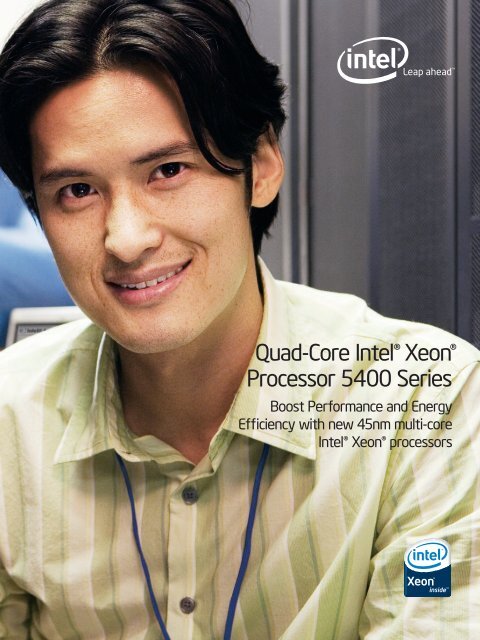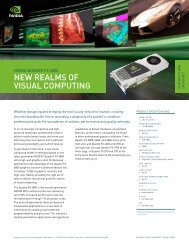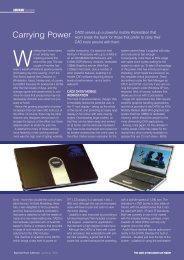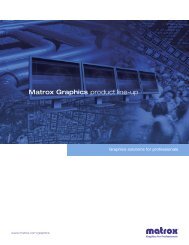Quad-Core Intel® Xeon® Processor 5400 Series - Intel szerver portál
Quad-Core Intel® Xeon® Processor 5400 Series - Intel szerver portál
Quad-Core Intel® Xeon® Processor 5400 Series - Intel szerver portál
You also want an ePaper? Increase the reach of your titles
YUMPU automatically turns print PDFs into web optimized ePapers that Google loves.
Business ServerNew 45nm• 5200 <strong>Series</strong>• <strong>5400</strong> <strong>Series</strong>Up to 2x 1333 MHz<strong><strong>Intel</strong>®</strong>ICH-9RI/OBridgeKey Technologies• High-performance multi-core CPUs• Excellent investment protection• <strong>Quad</strong>-<strong>Core</strong> and Dual-<strong>Core</strong> <strong>Intel</strong> Xeon processor capable• Power-efficient <strong>Intel</strong> <strong>Core</strong> microarchitecture• 6 slots of lower power DDR2 memory• Cost-optimized chipset and I/O controller• 30 lanes of configurable PCIeKey Capabilities• Optimized for small- and medium-sized businessesseeking enterprise-class performance and qualityon a constrained budget• General-Purpose Servers including:- e-mail<strong>Quad</strong>-<strong>Core</strong> or Dual-<strong>Core</strong><strong><strong>Intel</strong>®</strong> 5100 ChipsetConfigurable PCI Express* with 30 lanesExisting 65nm• 5300 <strong>Series</strong>• 5100 <strong>Series</strong>aConfigurable up to32 GB Max memory6 slots24 GB aNative DDR2Optimized for small and medium business, <strong>Quad</strong>-<strong>Core</strong> <strong>Intel</strong> Xeonprocessors offer solid performance and performance per wattfor basic business needs without sacrificing affordability. Theplatform is optimized for reduced cost and power consumption,featuring the <strong><strong>Intel</strong>®</strong> 5100 chipset and native DDR2 memory. Thisenables you to run more applications with a smaller footprint andbudget, giving you revolutionary ways to achieve more with less.Power and Performancefor More Efficient BusinessWith today’s competitive and budget pressures, it is criticalthat you get the maximum value and return from your resources.Server solutions based on <strong>Intel</strong> Xeon processors deliver powerfulbusiness capabilities at affordable prices, giving you the flexibilityyou need to reach new customers, increase your revenue andachieve your business goals. New 2-socket <strong>Quad</strong>-<strong>Core</strong> <strong>Intel</strong> Xeonprocessor <strong>5400</strong> series-based servers deliver new levels ofperformance for business processes, across a wide range ofbusiness workloads, including application servers, e-mail servers,Web servers and more.<strong>Intel</strong>’s second-generation quad-core processor, featuring a newcost optimized <strong><strong>Intel</strong>®</strong> 5100 Memory Controller Hub Chipset, andlow cost <strong>Intel</strong> ICH-9R I/O controller, and coupled with the energyefficient technology found in <strong>Intel</strong>’s 45nm silicon process, enablesimproved IT application performance with excellent power efficiencyand value. Supporting either one or two processors theplatform is further optimized for reduced power consumptionusing low power native DDR2 memory. The high performance,low power, and affordable technology found in these new businessservers helps you to run more business applications within asmaller IT footprint and giving you revolutionary ways to achievemore with less.- Web- File- Business apps
A Deep Look Inside the Enhanced<strong><strong>Intel</strong>®</strong> <strong>Core</strong> MicroarchitectureBuilding on the already rich <strong><strong>Intel</strong>®</strong> 64 instruction set architecture(ISA), <strong>Quad</strong>-<strong>Core</strong> and Dual-<strong>Core</strong> <strong>Intel</strong> Xeon processor <strong>5400</strong> and5200 series have new a instruction set that help the processorsto deliver superior performance and energy efficiency to a broadrange of 32-bit and 64-bit applications. These new instructionsinclude:• Streaming SIMD Extensions 4 (SSE4) that will provide buildingblocks for delivering expanded capabilities, enhanced performance,and greater energy efficiency for many applications.• Application Targeted Accelerators that will provide anew foundation for delivering low latency, lower powerfixed-function capabilities for targeted applications.These instructions represent another milestone in <strong>Intel</strong>'s newcadence for the continuous development of next-generationsilicon processes and processor architecture. Applications thatwill benefit include those involving graphics, video encoding andprocessing, 3-D imaging, gaming, web servers, and applicationservers. High-performance applications that will benefit includedata mining; database; complex searching and pattern matchingalgorithms; audio, video, image, and data compression algorithms;parsing and state machine-based algorithms; and many more.In addition, technical compute server platforms based on the<strong>Quad</strong>-<strong>Core</strong> <strong>Intel</strong> Xeon processor <strong>5400</strong> series also support manyadvanced technologies that help companies enhance operations,reduce costs, and speed productivity, including:• High-performance radix 16 dividers: that roughly doublethe divider speed over previous generations for scientificcomputations, 3D transformations, and other mathematicallyintensive functions.• Higher Bus Speeds: up to 1600 MHz for targeted segmentssuch as HPC.• Super Shuffle Engine: a single-pass shuffle unit that is128-bits wide, 45nm processors can perform this full-widthshuffle in a single cycle. This significantly improves performancefor SSE2, SSE3 and SSE4 instructions that haveshuffle-like operations such as pack, unpack and widerpacked shifts, increasing performance for content creation,imaging, video, and high-performance computing.For more information, visitwww.intel.com/xeon.
<strong>Quad</strong>-<strong>Core</strong> <strong>Intel</strong> Xeon <strong>Processor</strong><strong>5400</strong> <strong>Series</strong> OverviewTwo-processor technical compute servers, standard high-volume servers, entry-level business servers,and workstations based on the <strong>Quad</strong>-<strong>Core</strong> <strong>Intel</strong> Xeon processor <strong>5400</strong> series maximize performance andefficiency with reliability and versatility.FeaturesMulti-core ProcessingEnhanced <strong><strong>Intel</strong>®</strong> <strong>Core</strong>MicroarchitectureLarge 12 MB of on-die L2 Cache(2 x 6MB)<strong><strong>Intel</strong>®</strong> Virtualization Technology 1Enhanced Front-Side Bus<strong><strong>Intel</strong>®</strong> 64 Architecture 8Benefits• 45nm technology boosts performance on a range of workloads.• Increased headroom for multi-threaded applications and heavymulti-tasking scenarios.• Helps boost system utilization through virtualization 1 and applicationresponsiveness.• <strong>Quad</strong>-core performance and cost/virtual machines.• Platform-compatible with other <strong>Quad</strong>-<strong>Core</strong> and Dual-<strong>Core</strong> <strong><strong>Intel</strong>®</strong> <strong>Xeon®</strong>processors for ease of migration and IT stability.• Boosts performance on multiple applications/user environmentsand data-demanding workloads, while enabling denser data centerdeployments through improved performance per watt.• The new 45nm Enhanced <strong>Intel</strong> <strong>Core</strong> microarchitecture deliversup to 38% more performance per watt in the same platforms andat the same system power level. 7• Reduced idle processor power, lowers average server power consumption• Increases efficiency of L2 Cache-to-core data transfers, maximizingmain memory to processor bandwidth.• Reduces latency by storing larger data sets closer to the processor,reducing the number of trips to main memory.• Up to 6 MB of L2 Cache can be allocated to one core.• A suite of processor enhancements that assists virtualization softwareto deliver more efficient virtualization solutions and greater capabilitiesincluding 64-bit guest OS support.• <strong><strong>Intel</strong>®</strong> VT FlexPriority, a new <strong><strong>Intel</strong>®</strong> VT extension that optimizes virtualizationsoftware efficiency by improving interrupt handling. 2• <strong><strong>Intel</strong>®</strong> VT FlexMigration enables <strong>Intel</strong> Xeon processor <strong>5400</strong> and 5200series-based systems to be added to the existing virtualization pool withsingle, 2, or 4+ socket <strong>Intel</strong> <strong>Core</strong> microarchitecture-based servers.• New dedicated high-speed bus design enables increased throughputand bandwidth between each of the processors and the chipset.• Supporting up to 1600 MHz depending on chipset.• Flexibility for 64-bit and 32-bit applications and operating systems.
What is the 5000 Sequence?At <strong>Intel</strong>, our processor series numbers are intended to help clarify processor features, capabilitiesand intended usages. <strong>Intel</strong> offers four processor number sequences for server applications:<strong>Quad</strong>-<strong>Core</strong> and Dual-<strong>Core</strong> <strong><strong>Intel</strong>®</strong> <strong>Xeon®</strong>processor 3000 sequence One-processorservers for small business, entry, or first serverbased on the <strong>Intel</strong> Xeon processor.<strong>Quad</strong>-<strong>Core</strong> and Dual-<strong>Core</strong> <strong><strong>Intel</strong>®</strong> <strong>Xeon®</strong>processor 5000 sequence Two-processorgeneral-purpose, standard high-volume servers,HPC systems, and workstations based on the<strong>Intel</strong> Xeon processor.<strong>Quad</strong>-<strong>Core</strong> and Dual-<strong>Core</strong> <strong><strong>Intel</strong>®</strong> <strong>Xeon®</strong>processor 7000 sequence Greater scalabilitywith 4- to 32-processor enterprise serversbased on the <strong>Intel</strong> Xeon processor.Dual-<strong>Core</strong> <strong><strong>Intel</strong>®</strong> Itanium® processor9000 sequence Maximum performanceand scalability for RISC replacement usagewith 2- to 512-processor servers.<strong>Quad</strong>-<strong>Core</strong> <strong><strong>Intel</strong>®</strong> <strong>Xeon®</strong> <strong>Processor</strong> <strong>5400</strong> <strong>Series</strong>The <strong>Quad</strong>-<strong>Core</strong> <strong>Intel</strong> Xeon processor <strong>5400</strong> series is available in a range of features to matchdifferent computing demands. All processors integrate <strong>Intel</strong> Virtualization Technology and <strong><strong>Intel</strong>®</strong>64 Architecture, 8 and are available in the LGA771 packaging. Dual-core SKU options are also available.<strong>Intel</strong> Virtualization Technology, <strong>Intel</strong> FlexMigration, <strong>Intel</strong> FlexPriority and <strong>Intel</strong> 64 Architecture arestandard on all SKUs. With the exception of E5405, all SKUs also support Demand Based Switching.<strong>Processor</strong> Number ∆CPUFrequencyL2 CacheFront-SideNumberBus Speed Power b of <strong>Core</strong>s<strong>Quad</strong>-<strong>Core</strong> <strong><strong>Intel</strong>®</strong> <strong>Xeon®</strong> <strong>Processor</strong> X5482 a 3.20 GHz 12 MB 1600 MHz 150W 4<strong>Quad</strong>-<strong>Core</strong> <strong><strong>Intel</strong>®</strong> <strong>Xeon®</strong> <strong>Processor</strong> X5472 3.00 GHz 12 MB 1600 MHz 120W 4<strong>Quad</strong>-<strong>Core</strong> <strong><strong>Intel</strong>®</strong> <strong>Xeon®</strong> <strong>Processor</strong> E5472 3.00 GHz 12 MB 1600MHz 80W 4<strong>Quad</strong>-<strong>Core</strong> <strong><strong>Intel</strong>®</strong> <strong>Xeon®</strong> <strong>Processor</strong> E5462 2.80 GHz 12 MB 1600 MHz 80W 4<strong>Quad</strong>-<strong>Core</strong> <strong><strong>Intel</strong>®</strong> <strong>Xeon®</strong> <strong>Processor</strong> X5460 3.16 GHz 12 MB 1333 MHz 120W 4<strong>Quad</strong>-<strong>Core</strong> <strong><strong>Intel</strong>®</strong> <strong>Xeon®</strong> <strong>Processor</strong> X5450 3.00 GHz 12 MB 1333 MHz 120W 4<strong>Quad</strong>-<strong>Core</strong> <strong><strong>Intel</strong>®</strong> <strong>Xeon®</strong> <strong>Processor</strong> E5450 3.00 GHz 12 MB 1333 MHz 80W 4<strong>Quad</strong>-<strong>Core</strong> <strong><strong>Intel</strong>®</strong> <strong>Xeon®</strong> <strong>Processor</strong> E5440 2.83 GHz 12 MB 1333 MHz 80W 4<strong>Quad</strong>-<strong>Core</strong> <strong><strong>Intel</strong>®</strong> <strong>Xeon®</strong> <strong>Processor</strong> E5430 2.66 GHz 12 MB 1333 MHz 80W 4<strong>Quad</strong>-<strong>Core</strong> <strong><strong>Intel</strong>®</strong> <strong>Xeon®</strong> <strong>Processor</strong> E5420 2.50 GHz 12 MB 1333 MHz 80W 4<strong>Quad</strong>-<strong>Core</strong> <strong><strong>Intel</strong>®</strong> <strong>Xeon®</strong> <strong>Processor</strong> E5410 2.33 GHz 12 MB 1333 MHz 80W 4<strong>Quad</strong>-<strong>Core</strong> <strong><strong>Intel</strong>®</strong> <strong>Xeon®</strong> <strong>Processor</strong> E5405 2.00 GHz 12 MB 1333 MHz 80W 4Dual-<strong>Core</strong> <strong><strong>Intel</strong>®</strong> <strong>Xeon®</strong> <strong>Processor</strong> X5272 3.40 GHz 6 MB 1600 MHz 80W 2Dual-<strong>Core</strong> <strong><strong>Intel</strong>®</strong> <strong>Xeon®</strong> <strong>Processor</strong> X5260 3.33 GHz 6 MB 1333 MHz 80W 2Dual-<strong>Core</strong> <strong><strong>Intel</strong>®</strong> <strong>Xeon®</strong> <strong>Processor</strong> E5205 1.86 GHz 6 MB 1066 MHz 65W 2aWorkstation onlyb50W <strong>Quad</strong>-<strong>Core</strong> and 40W Dual-<strong>Core</strong> versions will be able in first quarter, 2008.10
Systems Designedfor Your NeedsHigh-Performance Computing Systemsand Workstation: <strong><strong>Intel</strong>®</strong> <strong>5400</strong> ChipsetThe <strong><strong>Intel</strong>®</strong> <strong>5400</strong> chipset improves data movement across <strong>Quad</strong>-<strong>Core</strong> <strong>Intel</strong> Xeon <strong>Processor</strong> <strong>5400</strong> series-based workstations andHPC systems by increasing interconnect bandwidth, optimizingsystem bandwidth, increasing memory capacity, and improvingnetwork traffic processing while reducing I/O latency. Theseplatform advancements help to match the improved performanceof the <strong>Quad</strong>-<strong>Core</strong> <strong>Intel</strong> Xeon processor <strong>5400</strong> series and include a1600 MHz Front-Side Bus, a 24 MB Snoop Filter to reduce traffic onthe Front-Side Bus, and support for dual x16 PCIe gen 2 ports tosupport I/O-intensive applications.Entry-Level Business Servers:<strong><strong>Intel</strong>®</strong> 5100 ChipsetThe new <strong><strong>Intel</strong>®</strong> 5100 MCH Chipset supports both quad- and dualcorecomputing and is ideal for small and medium businesses. Thechipset offers energy-efficient performance and the reliabilityyou need. With <strong><strong>Intel</strong>®</strong> Virtualization, DDR2, PCI Express,* serial ATARAID, <strong><strong>Intel</strong>®</strong> Active Management Technology, 9 and 1066/1333MHz DIB to improve network traffic processing.Standard, High-Volume Servers:<strong><strong>Intel</strong>®</strong> 5000p or 5000v ChipsetsWidely deployed since mid-2006 for enterprise and businesswith existing <strong>Quad</strong>-<strong>Core</strong> and Dual-<strong>Core</strong> <strong>Intel</strong> Xeon processors,two chipset versions enable flexible server configuration tomeet your goals.Performance: <strong><strong>Intel</strong>®</strong> 5000p chipset – This chipset supports1066 and 1333 MHz system bus speeds, three PCI Express x8links (each configurable as two x4 links), FBDIMM 533 and 667technology, point-to-point connection for <strong><strong>Intel</strong>®</strong> 6321 ESB I/OController Hub at 2 GB/s, and <strong><strong>Intel</strong>®</strong> 6700PXH 64-bit PCI hub.Value: <strong><strong>Intel</strong>®</strong> 5000v chipset – This chipset supports 1066 and1333 MHz system bus speeds, one PCI Express x8 link (configurableas two x4 links), FBDIMM 533 and 667 technology, point-topointconnection for <strong><strong>Intel</strong>®</strong> 6321 ESB I/O Controller Hub at 2 GB/s,and <strong><strong>Intel</strong>®</strong> 6700PXH 64-bit PCI hub.11
Performance ResultsMainstream Enterprise ServersSPECjbb2005*: X5460 vs X5365 - Published/measured results on SPECjbb2005* - Oct 2, 07Comparison between 5160, X5365 and X5450 based on SPECjbb2005 benchmark result<strong>Quad</strong>-<strong>Core</strong> <strong><strong>Intel</strong>®</strong> <strong>Xeon®</strong> processor X5365 based platform details: Dell PowerEdge* 1950 platform with two <strong>Quad</strong>-<strong>Core</strong> <strong>Intel</strong> Xeon processor X5365 3.0GHz, 2x4Mb L2 Cache,1333 MHz system bus, 16GB Memory DDR2-667 FBDIMM, Microsoft Windows Server 2003 Enterprise x64 Edition SP1 (64-bit), BEA JRockit 5.0 P27.2.0. Measured at 238,472bops and 59,618 bops/JVM. For more information see http://www.spec.org/jbb2005/results/res2007q3/jbb2005-20070810-00346.html<strong>Quad</strong>-<strong>Core</strong> <strong><strong>Intel</strong>®</strong> <strong>Xeon®</strong> processor X5460 based platform details: <strong>Intel</strong> Server pre-production platform with two <strong>Quad</strong>-<strong>Core</strong> <strong>Intel</strong> Xeon processor X5460 3.16GHz, 2x6Mb L2Cache, 1333 MHz system bus, 16GB Memory DDR2-667 FBDIMM, Microsoft Windows Server 2003 Enterprise x64 Edition SP1 (64-bit), BEA JRockit 5.0 P27.2.0. <strong>Intel</strong> internalmeasurement – September 2007SPECint*_ rate2006: X5460 vs X5365 - Published/measured results on SPECint*_ rate2006 - Oct 2, 07 with 64-Bit SUSE LINUX Enterprise Server 10 16GB (8x2GB). SPECbinaries built with <strong>Intel</strong> Compiler 10.1 for 32-bit/64-bit Linux<strong>Quad</strong>-<strong>Core</strong> <strong>Intel</strong> Xeon <strong>5400</strong> <strong>Series</strong> based platform (“Bensley/Harpertown”) common configuration details: <strong>Intel</strong> server pre-production platform with two <strong>Quad</strong>-<strong>Core</strong> <strong>Intel</strong> Xeon<strong>Processor</strong> X5460 (3.16GHz) w/ 2x6M L2 Cache, 1333 MHz FSB, 5000p “Blackford” Chipset. All measurements use FB DDR2-667 MHz memory<strong>Quad</strong>-<strong>Core</strong> <strong>Intel</strong> Xeon 5300 <strong>Series</strong> based platform (“Bensley/Clovertown”) common configuration details: <strong>Intel</strong> server pre-production platform with two <strong>Quad</strong>-<strong>Core</strong> <strong>Intel</strong> Xeon<strong>Processor</strong> X5365 (3.00GHz) w/ 2x4M L2 Cache, 1333 MHz FSB, 5000p “Blackford” Chipset. All measurements use FB DDR2-667 MHz memoryWorkstations: Workstation and Multi-Tasking EnhancementsSPECfp_rate2006<strong>Quad</strong>-<strong>Core</strong> <strong>Intel</strong> Xeon processor X5365 based platform details: Supermicro* X7DB8 with two <strong>Quad</strong>-<strong>Core</strong> <strong>Intel</strong> Xeon processors X5365 3.0GHz, 16 GB memory (8x2GB), 1333FSB, O/S 64-Bit SUSE Linux Enterprise Server 10, Kernel 2.6.16.21-0.8-smp for x86_64, <strong>Intel</strong> C++ Compiler for Linux version 10.1 & Smart Heap Library Version 8.1. Published atwww.spec.org as of September 4th 2007 at 66.9.45nm Hi-k <strong>Intel</strong> Xeon <strong>Quad</strong>-<strong>Core</strong> processor 3.20Ghz based platform details: <strong>Intel</strong> pre-production platform with two 45nm Hi-k <strong>Intel</strong> Xeon <strong>Quad</strong>-<strong>Core</strong> processors 3.20GHz, 1600FSB, 16 GB memory (8x2GB), O/S 64-Bit SUSE Linux Enterprise Server 10, Kernel 2.6.16.21-0.8-smp for x86_64, <strong>Intel</strong> C++ Compiler for Linux version 10.1 & Smart Heap LibraryVersion 8.1. Result measured at 89.8.Manufacturing “Working Differently” scenario SPECapc* SolidWorks* 2005 and Fluent* 6.3.26 L1/L2 workloads running 5x concurrently2x <strong>Quad</strong>-<strong>Core</strong> <strong><strong>Intel</strong>®</strong> <strong>Xeon®</strong> <strong>Processor</strong> <strong>5400</strong>-series (3.20 GHz, 1600 MHz FSB, 12 MB cache, formerly “Harpertown”) on “SunCity Stoakley” pre-production workstation comparedto 2x <strong>Quad</strong>-<strong>Core</strong> <strong>Intel</strong> Xeon <strong>Processor</strong> X5365 (3.00 GHz, 1333 MHz FSB, 8 MB cache) on SuperMicro* X7DA8 workstation, COMMON: 8 GB FBD-667 memory, WDC WD740GDHDD, Windows XP* Professional x64 SP1, NVIDIA* <strong>Quad</strong>ro* FX 4500 PCIe* x16 video card driver 91.36.Technical Compute ServersWeather Modeling (National Weather Services Application) and Financial Services (Black-Scholes application) running 8 threads with Red Hat EL4-U4 64-bit; 2.6.9-42.ELsmp<strong>Quad</strong>-<strong>Core</strong> <strong>Intel</strong> Xeon 5300 <strong>Series</strong> based platform (“Bensley/Clovertown”) common configuration details: <strong>Intel</strong> server pre-production platform with two <strong>Quad</strong>-<strong>Core</strong> <strong>Intel</strong> Xeon<strong>Processor</strong> X5365 (3.00GHz) w/ 2x4M L2 Cache, 1333 MHz FSB, 5000p “Blackford” Chipset. All measurements use 32GB (16x2GB) FB DDR2-667 MHz memory<strong>Quad</strong>-<strong>Core</strong> <strong>Intel</strong> Xeon <strong>5400</strong> <strong>Series</strong> based platform (“Stoakley/Harpertown”) common configuration details: <strong>Intel</strong> server pre-production platform with two <strong>Quad</strong>-<strong>Core</strong> <strong>Intel</strong> Xeon<strong>Processor</strong> X5472 (3.0GHz) w/ 2x6M L2 Cache, 1600 MHz FSB, 5xxx “Seaburg” Chipset. All measurements use 16GB (16x1GB) FB DDR2-800 MHz memoryPerformance and competitive information is accurate at the time of document publication. For the latest performance and competitive information,visit www.intel.com/performance.∆<strong><strong>Intel</strong>®</strong> processor numbers are not a measure of performance. <strong>Processor</strong> numbers differentiate features within each processor series, not acrossdifferent processor sequences. See http://www.intel.com/products/processor_number for details.1 <strong>Intel</strong> Virtualization Technology requires a computer system with a processor, chipset, BIOS, virtual machine monitor (VMM) and applications enabled for virtualization technology.Functionality, performance or other virtualization technology benefits will vary depending on hardware and software configurations. Virtualization technology-enabledBIOS and VMM applications are currently in development.2 <strong>Intel</strong> internal measurement. Platforms running 4 x <strong><strong>Intel</strong>®</strong> <strong>Xeon®</strong> <strong>Processor</strong> X7350, 32GB memory, vConsolidate Beta 2, Virtual Iron 4.0.2 software.1 CSU configuration, Sept 2007. Boot time improvement measured on Windows XP. vConsolidate measurement conducted by configuring thesystem with Windows 2000 SP43 <strong>Quad</strong>-<strong>Core</strong> <strong><strong>Intel</strong>®</strong> <strong>Xeon®</strong> <strong>Processor</strong> 5300 <strong>Series</strong> (“CTN”)Up to 25% (1.25x) higher Performance for <strong>Intel</strong> Xeon processor X5460 vs <strong>Intel</strong> Xeon processor X5365 - Published/measuredresults on SPECjbb2005* - Oct 2, 07. <strong>Quad</strong>-<strong>Core</strong> <strong><strong>Intel</strong>®</strong> <strong>Xeon®</strong> processor X5365 based platform details: Dell PowerEdge* 1950 platform with two <strong>Quad</strong>-<strong>Core</strong> <strong>Intel</strong> Xeonprocessor X5365 3.0GHz, 2x4Mb L2 Cache, 1333 MHz system bus, 16GB Memory DDR2-667 FBDIMM, Microsoft Windows Server 2003 Enterprise x64 Edition SP1 (64-bit),BEA JRockit 5.0 P27.2.0. Measured at 238,472 bops and 59,618 bops/JVM. For more information see http://www.spec.org/jbb2005/results/res2007q3/jbb2005-20070810-00346.html <strong>Quad</strong>-<strong>Core</strong> <strong><strong>Intel</strong>®</strong> <strong>Xeon®</strong> processor X5460 based platform details: <strong>Intel</strong> Server pre-production platform with two <strong>Quad</strong>-<strong>Core</strong> <strong>Intel</strong> Xeon processor X5460 3.16GHz,2x6Mb L2 Cache, 1333 MHz system bus, 16GB Memory DDR2-667 FBDIMM, Microsoft Windows Server 2003 Enterprise x64 Edition SP1 (64-bit), BEA JRockit 5.0 P27.2.0. <strong>Intel</strong>internal measurement – September 20074 Source: <strong>Intel</strong> measured results Oct 2, 2007 for SPECfp_rate_base2006* comparing Xeon X5472 (3.0GHz/12M L2 Cache/1600 MHz FSB, <strong>5400</strong> Chipset (pre-productionplatform) to Xeon X5365 (3.00GHz/8M L2 Cache/1333 MHz FSB). 2 (up to 50%) Source: <strong>Intel</strong> measured results Oct 2, 2007 for Financial Services (Black-Scholes application)running 8 threads with Red Hat EL4-U4 64-bit; 2.6.9-42.ELsmp comparing <strong>Quad</strong>-<strong>Core</strong> <strong>Intel</strong> Xeon 5300 <strong>Series</strong> based platform X5365 (3.00GHz/8M L2 Cache/1333 MHz FSB)to pre-production <strong>Quad</strong>-<strong>Core</strong> <strong>Intel</strong> Xeon <strong>5400</strong> <strong>Series</strong> based platform X5472 (3.0GHz/12M L2 Cache/1600 MHz FSB, <strong>5400</strong> Chipset (pre-production platform)5 Based on measured result on SPECfp*_rate2006 benchmark. SPEC binaries built with <strong>Intel</strong> Compiler 10.1 for 64-bit Linux. Servers are configured with 64-Bit SUSE LINUXEnterprise Server 10 and 16GB (8x2GB) of memory.6 <strong>Intel</strong> internal measurement as of May 10, 2007 using SPECint_rate_base2000* with <strong>Intel</strong> Xeon Tigerton <strong>Processor</strong> 2.93GHz. Results compare <strong>Intel</strong> measured <strong>Quad</strong>-<strong>Core</strong><strong>Intel</strong> Xeon Tigerton <strong>Processor</strong> (2.66GHz) or (2.93GHz), with 2x4M L2 Cache, 1066 MHz system bus, Clarksboro Chipset vs. published Dual-<strong>Core</strong> AMD Opteron* Model 8220SE(2.8SktF).7 <strong>Intel</strong> Server pre-production platform with two <strong>Quad</strong>-<strong>Core</strong> <strong>Intel</strong> Xeon processor E5450 3.0GHz, 2x6Mb L2 Cache or E5335, 2x4MB L2 Cache, 1333 MHz system bus, 16GBMemory DDR2-667 FBDIMM, Microsoft Windows Server 2003 Enterprise x64 Edition SP1 (64-bit), BEA JRockit 5.0 P27.2.0. <strong>Intel</strong> internal measurement – September 2007.Perf/Watt calculated by dividing the Performance by measured system power during steady state window.8 64-bit computing on <strong>Intel</strong> architecture requires a computer system with a processor, chipset, BIOS, operating system, device drivers and applications enabled for<strong><strong>Intel</strong>®</strong> 64 architecture. Performance will vary depending on your hardware and software configurations. Consult with your system vendor for more information.9 <strong><strong>Intel</strong>®</strong> Active Management Technology requires the platform to have an <strong><strong>Intel</strong>®</strong> AMT-enabled chipset, network hardware and software, as well asconnection with a power source and a corporate network connection. With regard to notebooks, <strong>Intel</strong> AMT may not be available or certain capabilitiesmay be limited over a host OS-based VPN or when connecting wirelessly, on battery power, sleeping, hibernating or powered off. For more information,see www.intel.com/technology/platform-technology/intel-amt/*Other names and brands may be claimed as the property of others.Copyright © 2007 <strong>Intel</strong> Corporation. All rights reserved. <strong>Intel</strong>, the <strong>Intel</strong> logo, <strong>Intel</strong>. Leap ahead., <strong>Intel</strong>. Leap ahead. logo, Xeon, <strong>Intel</strong> <strong>Core</strong>, andItanium are trademarks of <strong>Intel</strong> Corporation in the U.S. and other countries.Printed in USA 1007/HW/OCG/PP/5k Please Recycle 318678-001US








